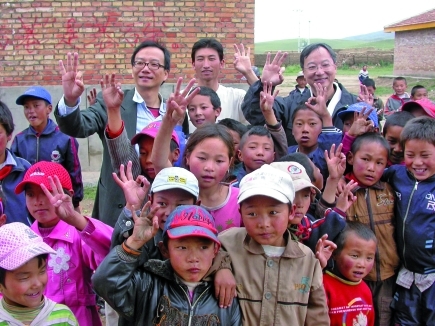Abstract
A million people die from viral hepatitis every year, yet until now the public health response has been patchy and piecemeal, overwhelmed by the sheer scale of the problem. Jane Parry reports.
“There is not a country in the world where viral hepatitis isn’t a problem.”
Charles Gore
“China accounts for 65% of the world’s hepatitis B problem and they’ve cracked it.”
Dr Andrew Hall
Viral hepatitis affects approximately 500 million people around the world – more than 10 times the number affected by HIV/AIDS.
Different viruses can cause various forms of viral hepatitis. While type A viral hepatitis is an acute and transient illness with low mortality, hepatitis B and C infections can become chronic and lead to liver cirrhosis and cancer. Hepatitis A is spread through contact with infected people or contaminated food or water – but hepatitis B and C are mainly acquired through contaminated needles or infected blood products.
Infection patterns are diffuse. Most people with some form of chronic viral hepatitis, which can remain latent for decades, don’t know how they became infected. All population groups are affected by viral hepatitis, but the poor are often the worst hit. Stigma and misinformation are rife. Treatment is expensive. In some countries, such as China, people who are chronically infected face discrimination.
An estimated 350 million people are chronically infected with hepatitis B – with Asia shouldering a disproportionately high burden – and 170 million with hepatitis C. The epidemic wreaks a trail of destruction wherever unsafe health care, injection and blood handling practices are common. Dr Steven Wiersma, medical officer and hepatitis focal point at the World Health Organization (WHO) in Geneva, says “the burden of disease is truly dramatic, yet viral hepatitis has been forgotten [and] misplaced”.
That is set to change now, since countries called for global concerted action to tackle the problem in a resolution passed in May 2010 at the 63rd World Health Assembly (WHA). “It was the strenuous efforts of patients’ advocacy groups that … put [it] on [the] WHA agenda,” Wiersma says. Countries recognized WHO’s “good work, for example in helping them with viral hepatitis prevention through immunization, and blood and injection safety education”, he says. The WHA resolution, passed unanimously, was a starting point for a global coordinated response, covering vaccination, testing and treatment for patients, education and advocacy for those living with the disease, and research and support to help countries formulate their own national responses.
More needs to be done to treat the millions of people living with chronic hepatitis and to prevent people dying from resulting liver cancer and liver cirrhosis, says Charles Gore, president of the World Hepatitis Alliance. More should be done to educate health-care workers about blood and needle safety and to fight the stigma and ignorance, Gore says. According to WHO estimates, every year there are 21 million cases of hepatitis B caused by unsafe injections in health-care settings.
“There is not a country in the world where viral hepatitis isn’t a problem,” he says. “HIV and malaria are only in certain countries, hepatitis is everywhere. In terms of infectious disease, you could say this is the biggest challenge we have, particularly given how little is in place to deal with it.”
The Viral Hepatitis Global Policy Survey was developed by the World Hepatitis Alliance in partnership with WHO after Member States were asked what they needed to step up their fight against viral hepatitis. The survey revealed deep concern: 80% of the 135 countries said viral hepatitis was an urgent public health issue but complained they had no money for it. One third of countries had no prevalence data at all. Countries said more than half of their populations had no access to free testing while very few governments ran public awareness campaigns about hepatitis. “We found that vaccination comes quite low down the list. All respondents wanted help with surveillance, goal setting and awareness. Once we started talking about it we were amazed that people recognized the need to do something,” says Gore.
For hepatitis C, there is no vaccine and the disease, often associated with injecting drug use, is found in diverse countries. It is prevalent in Egypt and Pakistan, for example, where people who receive health-care injections are most at risk of infection.
As for hepatitis B, vaccination has long been recognized as the key to bringing the disease under control. For just US$ 0.21 per dose (10-dose vials supplied by the United Nations Children’s Fund), three doses of hepatitis B vaccine starting at birth protect infants so effectively that the disease could be eradicated within several generations.
In 2005, WHO’s Western Pacific Region set a target for hepatitis B prevention. The region accounts for a third of the world’s population but more than half of deaths globally due to hepatitis B. It set 2012 as the target year to control hepatitis B by reducing the prevalence of chronic hepatitis B virus infection among five-year-olds from 8–10% down to less than 2% as an interim milestone, with a final goal of less than 1%. Although the hepatitis B vaccine has been introduced in all national immunization programmes in the Region, gaps in coverage persist.
China has set the standard in terms of implementing infant vaccination against hepatitis B and is a model for other countries in terms of both initial immunization programmes and catch-up campaigns, says Dr Andrew Hall, professor of infectious disease epidemiology at the London School of Hygiene and Tropical Medicine and chairman of the United Kingdom’s Joint Committee on Vaccination and Immunisation.
“China accounts for 65% of the world’s hepatitis B problem and they’ve cracked it. This generation of Chinese people will probably have lower rates of liver cancer than their contemporaries in the United Kingdom, as 85% of liver cancer in China is hepatitis-B related,” he says.
The Chinese government and the GAVI Alliance awarded US$ 35 million each to provide hepatitis B infant vaccination free of charge in China’s western provinces and other poor counties from 2002 to 2009. This large-scale rollout of birth-dose vaccination, in turn, prompted a policy change across the country. In June 2009, the Ministry of Health announced a catch-up programme to capture the estimated 68 million children who missed hepatitis B vaccination between 1994 and 2001.
“Chronic hepatitis B infections among under-fives are now less than 1%, compared to 10% ten years ago. This is a very dramatic reduction, many lives have been saved,” says Dr Xiaofeng Liang, director of the National Immunization Programme at the Chinese Center for Disease Control and Prevention. “However, there is still a need to increase coverage to remote areas and migrant workers.”
Similarly in neighbouring Mongolia, early results of surveys on hepatitis B prevalence among children are showing positive results since a national immunization campaign began in 1991. “In Mongolia, 80% of the population has been infected, 15% are chronically infected, and liver cancer is the biggest cancer in Mongolia both in morbidity and mortality among men and women,” says Dr Dambadarjaa Davaalkham, head of the Department of Epidemiology and Biostatistics at the Health Sciences University of Mongolia.
A 2004 survey found that, among children born after the start of the vaccination programme, 5.2% of those aged seven to 12 years were hepatitis B-antigen–positive. “This was much higher than in other countries. Now we are conducting a second survey, and preliminary results reveal that prevalence among four- to six-year-olds will now be close to 1%. In countries like Mongolia, where hepatitis is endemic, there is vertical transmission from mother to child, so if you can give the birth dose on time the main risk factor will be prevented,” says Davaalkham.
Other countries are also looking at the need for catch-up vaccination, according to Dr Samuel So, director of the Asian Liver Center at the Stanford University School of Medicine, and executive secretary of the Asia and Pacific Alliance to Eliminate Viral Hepatitis.
The Alliance has also worked with the health authorities in the Lao People's Democratic Republic to help the country meet its regional hepatitis B goals. “In 2009, 67% of infants received all three doses, and even fewer, 21%, of newborns received the important hepatitis B birth dose on time. We believe improving awareness and knowledge about the transmission routes and risk of hepatitis B and the benefits of vaccination is an important factor in improving rates of birth dose and overall immunization rates,” says So.
While China has become a shining example of effective immunization against hepatitis B, breaking down the social stigma against patients has been tough. Misconceptions about how viral hepatitis is transmitted go back to a major hepatitis A outbreak affecting 310 000 in Shanghai in 1988, which resulted in legislation that required hepatitis B testing for pre-school and pre-employment health checks. In August 2009, the Chinese Ministry of Health banned the inclusion of hepatitis B tests in such health checks, but reinforcement remains patchy, according to a 2010 report by the Beijing Yirenping Centre, a hepatitis B patients’ advocacy group.
“There is still a need in China for resources for a nationwide education campaign, not only to educate the public but also school children, so they understand the importance of prevention and do not discriminate against the 100 million Chinese who are infected,” says So.
Children at a catch-up vaccination programme in Qinghai, China, give the sign “Three shots OK for life”.
Asian Liver Center, Stanford University, Palo Alto, USA.
Poster educates children on hepatitis B vaccination in Qinghai, China.
Asian Liver Center, Stanford University, Palo Alto, USA.




